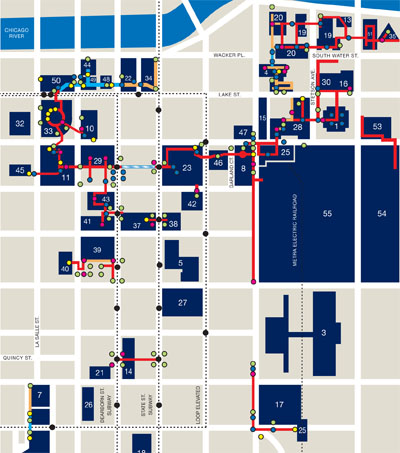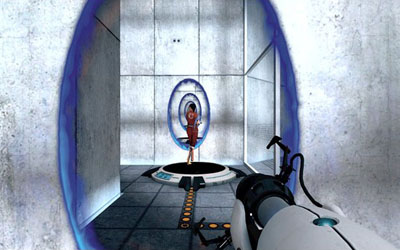Off the grid
BLDGBLOG has a wonderful post up comparing the way the building in the original Die Hard movie is used by the hero John McClane in every way except how it was designed to be used.
McClane explores the tower—called Nakatomi Plaza—via elevator shafts and air ducts, crashing through windows from the outside-in and shooting open the locks of rooftop doorways. If there is not a corridor, he makes one; if there is not an opening, there will be soon.
It’s a great essay, especially as it explores the real-world tactic [PDF] of Israeli troops who move through urban theaters by carving a path through the walls of adjacent buildings to remain unseen from the air or the street. (There’s also a fascinating digression on the way the new Bourne films use the city as a kind of weapon itself, contrasted with cities as mere setting for the gadget-dependent James Bond.)
But the main thrust of the piece comes from Die Hard: “[McClane’s] is an infrastructure of nearly uninhibited movement within the material structure of the building.”
This is the idea of the building as a network. And it scales up.
Our networked technologies already give us this sense of “uninhibited movement” within information space. If we consider the book an architectonic form (the Latin stanza means “room” after all) we see the emergence of the same dynamic of a decade ago when hypertext came into popular consciousness. Hyperlinks and unique IP addresses allowed us relatively uninhibited movement through a landscape of information, jumping to and fro, outside the linearity of the millennia-old codex.
I think what BLDGBLOG is pointing out are the cinematic imaginings — and military exigencies — that prefigure the way we increasingly think of the networked urban space as a mutable environment that can be bent to our will. It isn’t uninhibited in the truest sense (there are still walls to be destroyed or network outages to be dealt with), but barriers to movement are less dictated by the grid of streets and buildings than governed by another layer of experience, grounded in data and sensors.
Kazys Varnelis makes this point in another, powerful way:
In this condition of total urbanity, maps as navigational tools for the physical traversal of space are supplanted by intelligent maps for navigating a contemporary space in which the physical becomes a layer of data in a global informational space. If that space is created by society, it is also a space that, in its massive complexity, has become unknown to us, a second nature simultaneously also a second city and the space in which today’s identities are being formed. Much of this world is invisible and it is the task of the designer to help us understand it.
Intelligent maps — and a least a small number of films — help us think of the city as a platform for our own uses, related to but not wholly confined by the way it was physically built.

The physical city grid is vital, but even before networks and mobile technologies came to be the grid was made permeable by human need. Consider the Chicago Pedway. It’s an official but disjointed way of maneuvering through the central business district, initially constructed to give people a way of moving around safe from the elements. The Pedway is a series of tunnels and bridges that allow covered movement, wholly apart from the grid of streets and sidewalks. Desires lines, it seems, can sometimes be concretized. (As many of the diagonals is city street grids attest. Diagonals are often some of the earliest routes in the area showing human movement along paths of least resistance — or animal trails — that pre-date major settlement.)
There are thousands of other ways of moving through the dense city space that are, for now, merely habitual paths inside the heads of city pedestrians. Shortcuts through alleys, building lobbies, detours through subway connectors, or just routes that align with well-covered sidewalks. It is only a matter of time before these crowd-sourced paths of least resistance are made available via the network. (We’ve seen it in experiments like the “paths of least surveillance”, which of course is why the Israeli army does what it does.)
Of course, all dense, diverse urban areas would have walkscores of 100 if one could walk through walls. But we can’t and I’m not advocating the build-out of a completely porous physical environment or a LEGO-style recombinant cityscape. (Mark Z. Danielewski’s Tardis-like House of Leaves depicts one creepy end of this particular vector.) Constraint is as important as mutability. What’s physically available is as important as the ability to get to it.
But our concept of the city — what we can do with it — has changed because of the layer of networking and data that co-exists with it. Certainly ease of movement is increased, as is the act of information gathering (about nearby friends, businesses, and resources). But this is the low-hanging fruit. The real opportunity, it seems to me, comes from the analogy of the move from printed information to networked information: the ability we’ve been given to write to the space as well as read from it. Living in an architecture of information, we can more easily participate in its construction than we can with the physically built-environment. This is our right, if not a kind of civic duty for the information age. (More on this topic in a future post.)

The video game Portal is interesting to consider as a kind of embodiment of a mutable environment environment that still partakes of rigorous constraint. In Portal you move about a highly orthogonal, multi-room architected space with a gun that can blast “entry” and “exit” portals — basically teleporters. You can’t create portals just anywhere, though, and often you’ve link yourself into a corner. It’s surprisingly fun (and good for kids who like blasting things, minus the carnage). The point, I think, is that there’s a certain deep human satisfaction in carving one’s own path, bending a physical space to one’s own needs. Portal, like our tools of networked urbanism, succeeds by meeting that basic human desire.
BLDGBLOG makes the point that the Die Hard sequels would not have gotten progressively worse if they had not abandoned the simple premise of a hero who uses a physical space to his own ends, suggesting that scaling Nakatomi plaza up to the level of a city in future installments would have been the logical (and entertaining) next step. I don’t disagree, but we don’t need Hollywood to do it for us. The city of information is being built, piecemeal, by the lived experience of its human actors everyday, an elaborate movie set overlaid on a functioning city street.














Yes! Portal is a useful analogue to Weizman’s ideas ….
http://www.aggregat456.com/2008/03/game-space1-portalfez.html